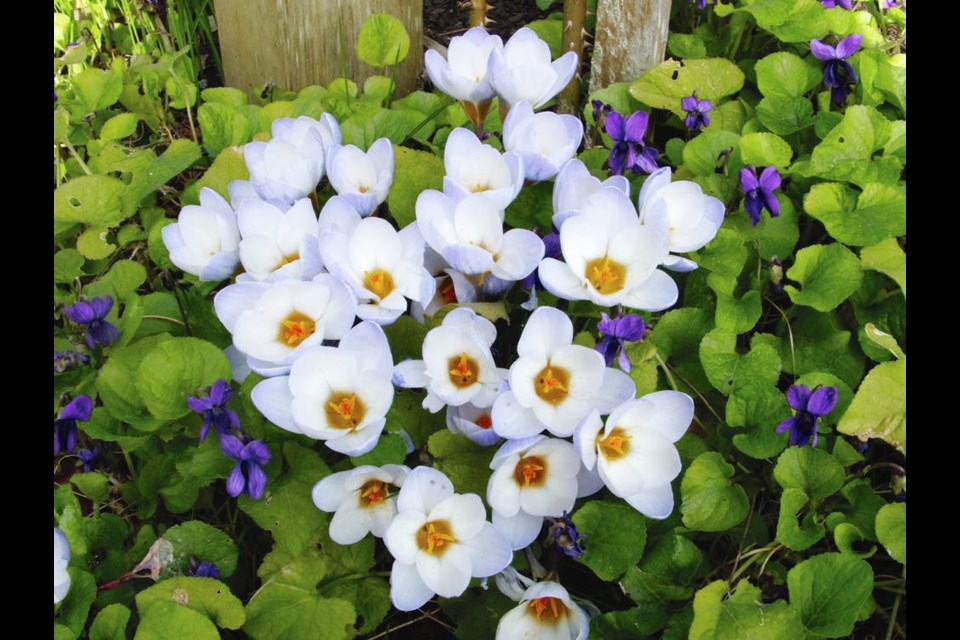Dear Helen: What can you tell me about planting spring-flowering bulbs using a “layering” method? It’s been a while since I’ve heard or seen the method described.
L.B.
A few years back, planting bulbs in tiers was very popular and written about often as a way of packing as many bulbs as possible into pots and garden spaces. The bulbs are planted in two or three layers.
For a container planting with three layers of bulbs, begin by filling a pot or planter about a third full. The bottom tier of larger bulbs will be nestled into this base layer of planting mix.
This layer will be the last to bloom. I usually choose a mid-season tulip such as a Triumph or Darwin Hybrid, or double-flowered or split-cup daffodils. These bloom in April, late in the daffodil season Sometimes I plant a tulip-daffodil combination as the bottom layer of large planters. I avoid late, May-flowering tulips for any containers I’ll need to be free in May for planting summer flowers.
Nestle the bases of the bulbs gently into the soil, close together but not touching each other or the container sides. Then add planting mix over the bulbs, enough to cover the bulb tops by at least five cm when the mix is pressed down gently.
Now plant the middle layer. This could be Trumpet or Cupped daffodils, Single Early or Double Early tulips, or hyacinths — or any combination of these.
The top layer will comprise any one or a combination of small, early-flowering bulbs such as crocus, dwarf iris, glory of the snow (Chionodoxa), early dwarf daffodils, or Anemone blanda. Cover the tips of these small bulbs with just around three cm of soil.
The bulbs can be similarly layered in a chosen spot in the garden, by digging a hole as wide as the space to be planted. The excavated soil, and the base of the hole, should be amended with fertilizer and compost before planting begins.
Dear Helen: What is the ideal stage for harvesting pumpkins and winter squash?
S.P.
Both can be harvested when the leaves have mostly died back on the vines and the stem is dry and shriveled. Leave at least eight cm of stem on the fruits. To harden the skins for successful storage, place the squashes and pumpkins in a dry, warm place (around 27 C) with good air circulation for seven to 10 days before storing in a dry location at around 15 C. I use a small hallway beside my front door, which faces north. Temperatures remain cool there.
Dear Helen: I would like to add trilliums to the forest of ferns that grow under the tall trees on my property. Where can I buy them?
G.S.
A few phone calls to your local garden centres may unearth a source or two of nursery-propagated trillium plants. The most extensive selection I know of is on Salt Spring Island, at Fraser’s Thimble Farms. Visit thimblefarms.com to see the list and plant descriptions.
Be aware that trilliums establish and naturalize best in a rich, moist, well-drained soil.
Dear Helen: I have a problem with rats in my greenhouse. I do not want to use poison, and I can’t prevent entry as there are so many ways to get into a greenhouse. Is there anything that will repel them?
A.P.
You could try mint. I use cotton balls soaked in peppermint extract in my old, hole-ridden garden shed to deter mice. I hear this method works for rats too.
When a friend had a problem with rats eating the melons and other things in her greenhouse, someone at her local Buckerfield’s store advised her to use an electronic trap. It’s efficient and not messy. All that is needed is to empty the trap and make sure the battery is charged. It worked well for her.
GARDEN EVENT
Lecture series. The Gallery Associates of the Art Gallery of Greater Victoria are offering two “Gardens As Art” lectures, in Zoom webinar form, on Sunday, Oct. 18 and Oct. 25, from 2 to 4 p.m. In the first lecture, David E. Young will present “Shibusa Aesthetics: Spontaneity in Japanese Gardens.” On Oct. 25, Betsy Tumasonis will present “Niki de Saint Phalle’s Tarot Garden in Tuscany.” Tickets are available online at aggv.ca/sunday-art-lecture-2020. Details on the lectures can be found on the site.



